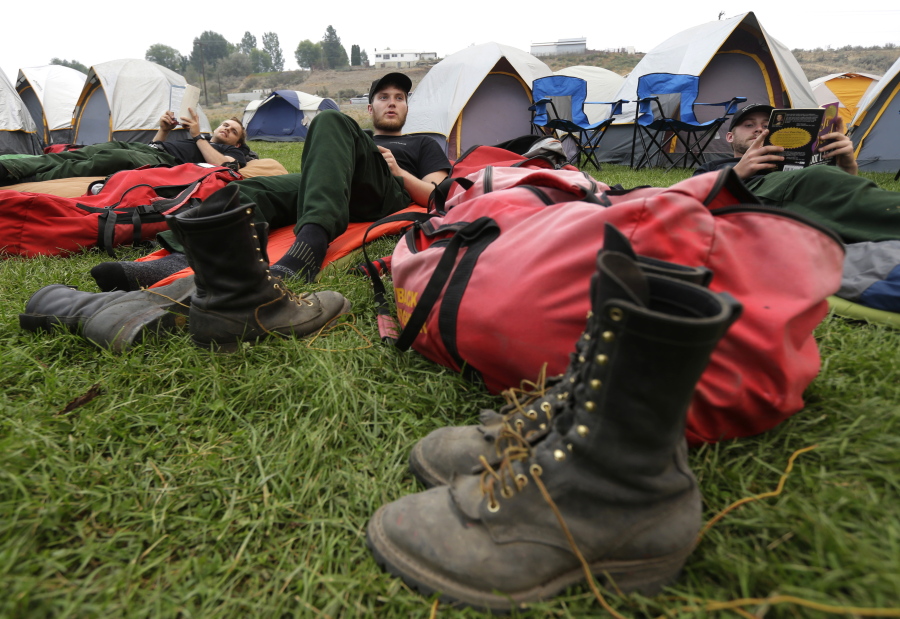BOISE, Idaho — Empty cow pastures on one day can be bustling with hundreds of firefighters the next as fire camps with colorful tent cities spring up.
More than 20,000 wildland firefighters are battling some 100 large wildfires in the U.S. West, and truckloads of supplies and equipment are needed to keep them effective at fighting flames for weeks on end.
“We’ll set up a small village,” said Evans Kuo, a “Type 1” incident commander assigned to the nation’s biggest and most dangerous wildfires. His incident command team has 44 members. “The main idea of the camp is to not only house the incident command team, but also house the base camp that has food, water, sleeping and showers.”
- HOW LARGE ARE FIRE CAMPS?
The size of each camp is determined by the size and complexity of the wildfire, with the largest blazes drawing more than 1,000 firefighters and support staff that are directed by Type 1 incident command teams.
U.S. Interior Department agencies, primarily the Bureau of Land Management, and the U.S. Forest Service supply firefighters, as do state agencies and tribes.
There also are Type 2 command teams on smaller and less complex blazes that draw from about 200 to 500 firefighters. Type 3 incidents may or may not have a fire camp.
More than 95 percent of all wildfires are put out quickly or within days by local firefighters, and are classified as Type 4 or 5. They typically don’t have fire camps.
Food caterers, semi-trailers with shower stalls and portable bathrooms are brought into large fire camps to make sure firefighters get enough food and a chance to wash off the dirt, ash and sweat.
“That’s a huge morale boost out on the line,” said Bubba Pugh, who has been fighting wildfires with the Idaho Department of Lands for about a decade. “Having the fire camp helps us get the job done.”
- WHO’S IN CHARGE OF A FIRE CAMP?
An incident commander with decades of firefighting experience runs the show, plotting short-term and long-term strategy that’s recalibrated daily. Fire camp responsibilities are separated into divisions that include planning, logistics, communications, medical and even security.
Public information officers help inform area residents through social media and news outlets. They also work with law enforcement officials on evacuations and road closures.
Camps also include someone tracking the overall cost of fighting the fire, which can run into the millions of dollars. The federal government spent $2.3 billion fighting wildfires last year, a number that’s expected to grow significantly this year.
- WHERE ARE FIRE CAMPS LOCATED?
Kuo said schools make good fire camps because they have electricity and internet access, something that has become increasingly important in fighting fires. Information can be distributed to firefighters on smartphones using code scanners.
Firefighters bring their own tents, and can set up on athletic fields or, if in more remote areas, anywhere from meadows to cow pastures.
“Sometimes we don’t get the most luxurious fields to sleep in,” Pugh said. “But find a nice, flat piece of ground, and just expect to be there for the duration.”
Communication in remote locations is mainly done through handheld radios. Communications teams put repeaters — devices that receive radio signals and retransmit them — on ridgetops so commanders can communicate with firefighters in the field.
The National Interagency Fire Center in Boise has the largest store of handheld radios outside the U.S. Department of Defense. Center spokeswoman Jessica Gardetto said most of the center’s radios, about 23,000, are at large wildfires. All radios are not in use at the same time as they need to be charged.
Remote command posts are often operated from yurts, or office trailers, with different divisions having their own workspace.
- HOW AND WHEN IS FOOD SERVED?
Firefighters get three calorie-heavy meals a day and snacks to keep them fueled for the physically intensive work.
Before the coronavirus pandemic, firefighters gathered in chow halls in the morning and evening, enjoying the camaraderie of the job while away from the fire line. Now, firefighters disperse to eat their meals, sometimes going back to their tents or finding a tree to sit under. Lunch is typically a bag lunch eaten in the field.
At satellite camps, pre-cooked food is flown to them.



